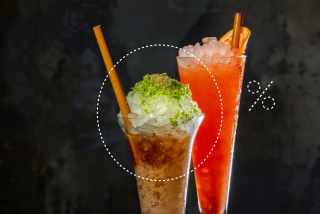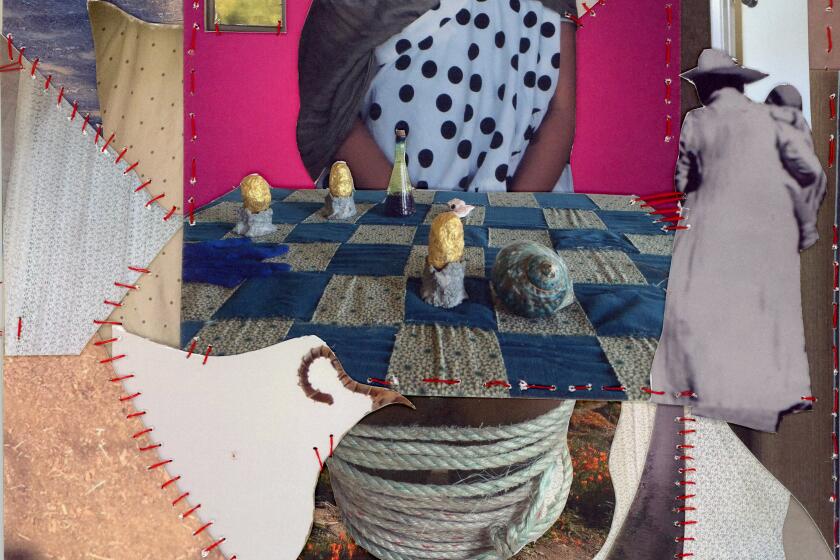Like the X-Games, but for beer

The 26th annual Great American Beer Festival, as attendees were constantly reminded last weekend, is the biggest beer tasting in the world: While judges evaluated the 2,793 beers that had been submitted in competition, 408 breweries and brew pubs poured tastes for some 46,000 people over three days at the Colorado Convention Center.
This is the place to see what the avant-garde of craft brewing is up to. The hot trend this year clearly is sour beers. There were so many entries -- 61 -- that the festival divided the field into three categories for judging.
The GABF is the Oscars of craft brewing. Big national breweries pay attention to the GABF -- they even submit some of their own beers for judging -- but any little brew pub can join in. Taps Fish House & Brewery in Brea took home a silver and a bronze (for imperial stout and American lager, respectively).
Though there’s serious beer connoisseurship going on here, any beer event is bound to have an element of hilarity. Hundreds of people in funny T-shirts walked around wearing strings of pretzels as necklaces, and any time somebody dropped a tasting glass, a sympathetic roar would shake the hall. (In the early days of the GABF, back in the 1980s, people roared because dropping a logo glass meant the tragic loss of a prized souvenir; the tradition is enthusiastically maintained even though at most sessions you now get unbreakable plastic glasses.)
But sour beer? It just sounds like a mistake. On the other hand, that’s what most of us would have said 20 years ago if somebody had described a beer as “insanely bitter.” This year American-style India pale ale, which is typically insanely bitter, was the largest category at the GABF.
Sour beer is another wild idea from Belgium. American brewers have been eagerly studying traditional Belgian ale styles, some of which are sour. Lambic and gueuze are the best known, but the sour Flemish red and brown ales are also attracting a lot of attention among craft brewers.
The main thing that makes the beers sour is brettanomyces, a yeast that winemakers fear and detest. Brett, as it is usually called, can certainly spoil the taste of wine. Not only will it make wine sour, it also adds unplanned and most unwine-like flavors. But at the GABF, you could hear sour beer connoisseurs muttering brett descriptors -- “horse manure, wet leather, tobacco” -- as terms of praise.
Some craft brewers also add bacteria such as pediococcus and lactobacillus to make their beer even more sour. Vinnie Cilurzo of Russian River Brewing says his most extreme beer, Beatification, “frightens the taste buds” and would go well with salad. It is shockingly sour, a bit like Rose’s Lime Juice straight from the bottle.
Nevertheless, the Russian River booth was one of the most popular at the event. The line extended all the way across the aisle -- you had to feel sorry for Pagosa Brewing Co. on the other side, because nobody could get to its booth.
Sour beers tend to be highly distinctive. Here’s an idea of the range: On the mild end, Jolly Pumpkin Artisan Ales, of Dexter, Mich., presented a Flemish red ale, La Roja, which had a mild taste of apples, followed by a little spicy snap and a long gentle finish of caramel and sour fruit. Allagash Brewing, of Portland, Maine, was pouring Interlude, which has a nose of spearmint and black pepper and a palate of pepper, apples and bread crusts.
On the extreme end, some of the sourest came from California, the home of extreme beer styles.
Russian River won a silver medal in the Belgian-style sour ale for Supplication, a brown ale aged in used French Pinot Noir barrels. Its flavor is almost impossible to capture in words: plums, lemon juice, wine, Moroccan pickled lemons? Maybe cheese, cabbage and ketchup too?
These terms don’t suggest how elegant yet comfortable the flavor is. You’d better find the taste likable, in any case, because it may persist on your palate for hours.
In the newly created category for wood- and barrel-aged sour beer, Russian River won another silver for Temptation, aged in Chardonnay barrels, which is lighter and slightly bubbly. But the gold medal in that category went to Lost Abbey Brewery of San Marcos, which was also judged the best small brewery in the country. (Lost Abbey is associated with the San Diego-based Pizza Port brew pub chain, which took home three medals of its own.)
Lost Abbey’s winner was Cuvee de Tomme, named for brewer Tomme Arthur. Tasting it, you might not think of beer at all. Fermented with raisins and sour cherries and aged for a year in used Bourbon barrels with wild brettanomyces yeast and more sour cherries, it has a dense nose of prunes, cherries, molasses and chocolate. In the mouth it’s sweet with a sarcastic edge of fruit acidity and a spicy burn.
It doesn’t taste like any beer that has ever existed, but there’s never been a wine like this either. It’s something all its own.
Is this the wave of the future? If so, it means we’re going to have to rethink all our ideas about food pairing. Traditionally, you use beer where the fruit acidity of wine would make a bad match with food; with sour beer -- well, you’re on your own.
I mean, you brett your life.
More to Read
Sign up for our L.A. Times Plants newsletter
At the start of each month, get a roundup of upcoming plant-related activities and events in Southern California, along with links to tips and articles you may have missed.
You may occasionally receive promotional content from the Los Angeles Times.






